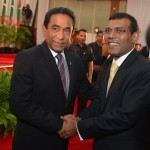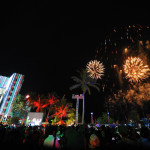Fifty percent of the electricity needs on the island of Thinadhoo in Gaaf Dhaalu Atoll are now being provided by solar panels.
Roof-mounted 250kWp (kilowatt peak) photovoltaic (PV) systems were installed in the regional hospital and mosque on the island today.
Speaking at a ceremony in Thinadhoo this morning to mark the grid connection of the solar panels, Minister of Environment and Energy Ibrahim Thoriq observed that the PV system was the largest of its kind in the atolls.
Along with a 308kWp system installed earlier, Thoriq noted that solar panels in Thinadhoo could now generate 50 percent of electricity used daily.
Thoriq also noted that the Maldives was heavily dependent on imported oil for its energy needs, which was a burden on the domestic economy.
“In 2013 alone, about MVR6 billion was spent on importing petroleum products,” Thoriq reportedly said.
According to the energy ministry, the solar PV component of the ‘Clean Energy for Climate Mitigation Project’ was carried out in two phases.
The first phase involved the installation of 308kWp solar photovoltaic systems in 3 buildings, explained the ministry – Thinadhoo School, Aboobakuru School, and the Powerhouse Building. During phase two, 250kWp solar photovoltaic systems were installed in two additional buildings – the Dr Abdul Samad Memorial Hospital and mosque.
“In addition to the solar PV component, energy conservation and efficiency activities were also carried out as part of this project. In this regard, energy audits of 20 different places were conducted, which includes government buildings, private offices and households,” said a ministry statement.
Based on the findings of the audits, energy efficient inverter air conditioners LED bulbs and LED tube lights were provided to the selected buildings.
Additionally, 5,000 LED bulbs were distributed to households in Thinadhoo under the energy efficiency demonstration component.
At today’s ceremony – which was attended by Progressive Party of Maldives MPs Ahmed Nihan and Saudhulla Hilmy as well as Fenaka Corporation Managing Director Mohamed Nimal – Thoriq reiterated the government’s objective of generating up to 30 percent of electricity used during daylight hours in all inhabited islands within the next four years.
Diesel fuel currently accounts for the bulk of the energy supply in the country – about 82.5% in 2009.
According to the Maldives Customs Service, of the MVR7.2 billion (US$466.9 million) worth of goods imported in the first quarter of 2014, one-third was spent on petroleum products.
The Maldives’ 109 resorts use 49 percent of the US$470 million diesel imported into the country annually. The figure amounts to over a third of the country’s GDP. The capital Malé uses 90 percent of the inhabited islands’ energy consumption.
A 100 percent solar-powered luxury resort called Gasfinolhu is meanwhile scheduled to open for business in January 2015.
Related to this story
Government targets generating 30 percent of electricity from renewable sources
Maldives’ solar ambitions stall due to politics, financing, “restructuring”
Fully solar powered Maldives resort sets new standard in green tourism






This is a good initiative. However the figures quoted are confusing. It is clear the total installed capacity is 558 kWp. What is the energy (kWh or Megawatt hours) produced from the solar PV system? Electricity produced is measured in energy (kWh) not load (kW).